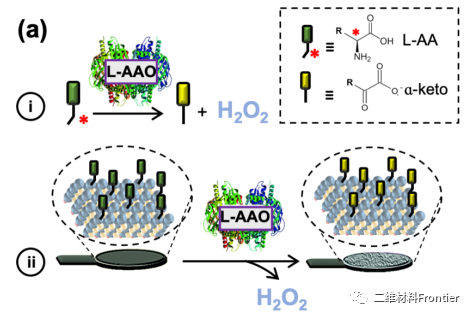
hotline:
17715390137
Tel/Wechat:
18101240246 (Technology)
0512-68565571
Email:mxenes@163.com (Sales Engineer)bkxc.bonnie@gmail.com
Scan the code to follow or search the official account on WeChat:
2D Materials Fronrier After paying attention,
click on the lower right corner to contact us,
Enter enterprise WeChat.
Professional Services Online

I. Overview of the article.
The design and manufacture of versatile active nanomaterials is a necessary condition for the so-called fourth global industrial revolution. In this sense, molecular engineering is a skilled tool for implanting raw capabilities on a macro scale. Here, different biologically inspired 2D-MXenes has been developed through a general and direct synthesis method. As a proof of concept, MXene has been developed as a highly sensitive trend. This paper demonstrates the use of the inherent characteristics of implanted molecular components to make programmable 2D-Ti3C2Tx.
Second, guided reading of picture and text.

Figure 1. Implanted molecules with multi-functional programmable biologically activated 2D-MXenes.
A schematic diagram of the chemical functionalization of Ti3C2Tx with different tryptophan (Trp) or aspartic acid (Trp). In addition, it also includes the main molecular properties of the transfer from selected amino acids to functionalized Ti3C2Tx.

Figure 2. Characterization of partial 2D-Ti3C2Tx carrying molecules.
Characterization of biologically activated 2D-MXene covalently functionalized with L-tryptophan and L-Trp@Ti3C2Tx. In the figure, especially the accordion-like structure of the original Ti3C2Tx is replaced by a single sheet in the L-Trp@Ti3C2Tx after chemical functionalization. As a result, the intercalation of L-Trp has been shown to facilitate a clear delamination process, just as it occurs in alternative layered two-dimensional materials. As shown in figure c, in order to gain a more in-depth understanding of the surface modification, the author also obtained a SEM image with higher magnification under Ti3C2Tx.

Figure 3. L-Tr2Tx@Ti3Trp optical properties of assembled L-Trp molecules.
Fluorescence: standardized (canonical) excitation (dotted line) and emission (solid) spectra of L-Trp at Ti3C2Tx. Mosaic: the emission spectrum of the original Ti3C2Tx. Chirality: average (n = 20) electron circular dichroism (CD) spectrum of L-Trp@Ti3C2Tx (light red) and its polynomial fitting (dark red). Mosaic: the CD spectrum of the original Ti3C2Tx.

Figure 4. Biologically excited 2D-Ti3C2Tx is used as a fluorescence biosensor probe for aromatic molecules.
Figure a, (I) schematic diagram of the luminescence properties of L-Trp@Ti3C2Tx; (ii) Foster resonance energy transfer (FRET) phenomenon between aromatic skeletons (inert units) of L-Trp through π-π interaction; figure b, Foster resonance energy transfer (FRET) phenomenon caused by π π interaction between L-Trp and graphene quantum dots (GQD) in L-Trp@Ti3C2Tx.

Figure 5. Biologically excited pH-driven molecular switches.
A schematic diagram showing the pH response capability of LTrp@Ti3C2Tx; (b) using LTrp@Ti3C2Tx s glass carbon electrode to obtain two actual part contribution capacitors of different power (pH7.2: red; pH11: blue).

Figure 6. Chiral biometric ability originates from the anchored amino acid part of biologically excited 2D-Ti3C2Tx.
III. Summary of the full text.
To sum up, programmable bio-inspired 2D-Ti3C2Tx with multi-function of implanted molecules has been developed through a simple and multi-functional method. For this reason, different amino acid parts are covalently anchored on the Ti3C2Tx matrix. Several key molecular properties have been proved to be successfully transferred to MXene. The important findings reported in this paper are helpful to expand the research field of the multi-function of transfer molecules. In general, a wide range of original customization functions can be easily designed by customizing molecular components.
This information is from the Internet for academic exchange only. if there is any infringement, please contact us to delete it immediately.

| Reminder: Beijing Beike New Material Technology Co., Ltd. supplies products only for scientific research, not for humans |
| All rights reserved © 2019 beijing beike new material Technology Co., Ltd 京ICP备16054715-2号 |